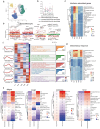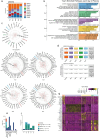Reading of human acute immune dynamics in omicron SARS-CoV-2 breakthrough infection
- PMID: 40231451
- PMCID: PMC12064115
- DOI: 10.1080/22221751.2025.2494705
Reading of human acute immune dynamics in omicron SARS-CoV-2 breakthrough infection
Abstract
The dynamics of the immune response to severe acute respiratory syndrome coronavirus 2 (SARS-CoV-2) breakthrough infections remain unclear, particularly when compared to responses in naive individuals. In this longitudinal prospective cohort study, 13 participants were recruited. Peripheral blood samples were collected every other day until day 7 after symptom onset. Transcriptome sequencing, single-cell sequencing, T-cell receptor (TCR) sequencing, B-cell receptor (BCR) sequencing, Olink proteomics, and antigen-antibody binding experiments were then performed. During the incubation periods of breakthrough infections, peripheral blood exhibited type 2 cytokine response, which shifted to type 1 cytokine response upon symptom onset. Plasma cytokine levels of C-X-C motif chemokine ligand 10, monocyte chemoattractant protein-1, interferon-γ, and interleukin-6 show larger changes in breakthrough infections than naïve infections. The inflammatory response in breakthrough infections rapidly subsided, returning to homeostasis by day 5 after symptom onset. Notably, the levels of monocyte-derived S100A8/A9, previously considered a marker of severe disease, physiologically significantly increased in the early stages of mild cases and persisted until day 7, suggesting a specific biological function. Longitudinal tracking also revealed that antibodies anti-Receptor Binding Domain (anti-RBD) in breakthrough infections significantly increased by day 7 after symptom onset, whereas cytotoxic T lymphocytes appeared by day 5. This study presents a reference for interpreting the immunological response to breakthrough infectious disease in humans.
Keywords: Breakthrough Infection; COVID-19; Early stage; Immune response; Innate immunity; SARS-CoV-2.
Conflict of interest statement
No potential conflict of interest was reported by the authors.
Figures






Similar articles
-
Multi-omic characteristics of longitudinal immune profiling after breakthrough infections caused by Omicron BA.5 sublineages.EBioMedicine. 2024 Dec;110:105428. doi: 10.1016/j.ebiom.2024.105428. Epub 2024 Nov 13. EBioMedicine. 2024. PMID: 39536392 Free PMC article.
-
Clinical and humoral response after SARS-CoV-2 breakthrough infection in patients receiving immunosuppressant therapy.J Allergy Clin Immunol. 2024 Sep;154(3):754-766.e7. doi: 10.1016/j.jaci.2024.04.031. Epub 2024 May 17. J Allergy Clin Immunol. 2024. PMID: 38763170
-
Humoral and cellular immune response from first to fourth SARS-CoV-2 mRNA vaccination in anti-CD20-treated multiple sclerosis patients-a longitudinal cohort study.Front Immunol. 2024 Sep 5;15:1432348. doi: 10.3389/fimmu.2024.1432348. eCollection 2024. Front Immunol. 2024. PMID: 39301017 Free PMC article.
-
Early 2022 breakthrough infection sera from India target the conserved cryptic class 5 epitope to counteract immune escape by SARS-CoV-2 variants.J Virol. 2025 Apr 15;99(4):e0005125. doi: 10.1128/jvi.00051-25. Epub 2025 Mar 26. J Virol. 2025. PMID: 40135898 Free PMC article.
-
T-Cell Responses to COVID-19 Vaccines and Breakthrough Infection in People Living with HIV Receiving Antiretroviral Therapy.Viruses. 2024 Apr 24;16(5):661. doi: 10.3390/v16050661. Viruses. 2024. PMID: 38793543 Free PMC article.
References
-
- COVID-19 Vaccines Advice . https://www.who.int/emergencies/diseases/novel-coronavirus-2019/covid-19... [accessed 2024 May 1].
MeSH terms
Substances
LinkOut - more resources
Full Text Sources
Other Literature Sources
Medical
Research Materials
Miscellaneous
